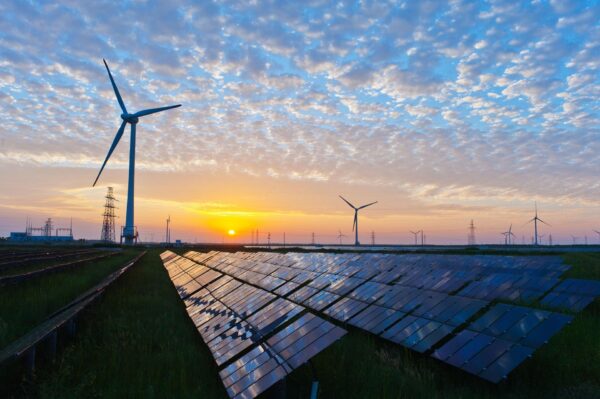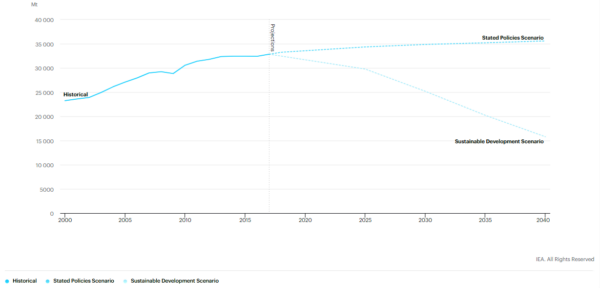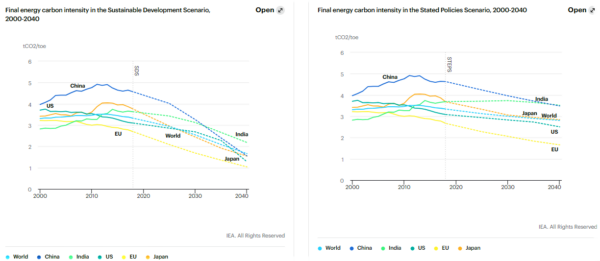The Paris Agreement (April 2016) sets out a global framework to avoid unprecedented climate change by trapping global warming to below 2°C while pursuing efforts to limit it to 1.5°C above pre-industrial levels. Since energy sector alone is responsible for three-quarters of greenhouse gas (GHGs) emissions, a wholistic transformation of the sector will be necessary to achieve this target in this century.
While the world’s current objective is to reduce the global Carbon Dioxide (CO2) emissions to net-zero by 2050, a recent report by IEA (International Energy Agency) clearly states that we are off track of what is needed to achieve this goal. It is evident that there exists a gap between the Stated Policies Scenario (SPS) and the Sustainable Development Scenario (SDS) therefore making it highly imperative that they be explored and focus be laid on the indicators stated by IEA to make the transition to Net Zero Emissions.
One of the key indicators for any country or region to successfully make the clean energy transition is energy-related carbon emissions. For instance, India being one of the largest emitters of annual CO2 is expected to emit 3.6 GT (Giga Tones) in 2030 driven by energy demand growth.
Simultaneously, the country has, and is expected to record very little change in the final energy carbon intensity, i.e total energy-related carbon emissions in CO2 per unit of final energy consumption. In order to reach the net zero target, the rate at which carbon intensity declines needs to at least double therefore scaling up India’s intensity rate from 0.2% to 2.4% on an average. India therefore needs drastic decarbonization when it comes to the energy sector in order to fulfill its Intended Nationally Determined Contribution (INDC) pledges.
According to IEA, direct use of low-emissions electricity as an alternative to fossil fuels or electrification of end use energy can act as a catalyst, offering a quick and cost-effective path for decarbonization. However, in order to achieve targets in the electrification of the energy driven sectors (subsectors), it is crucial that the power generated is hugely low-carbon.
Globally, the electricity demand is undeniably expected to show a steep rise in the next three decades. In the industrial sector itself, electricity demand is likely to record an increase of more than 11000 TWh (Terawatt-hour) between 2020 and 2050. Similarly, transport sector will show a considerable rise from less than 2% in 2020 to more than 45% by 2050. A surge in electricity demand will also be recorded from construction and housing and for production of low-carbon fuels like hydrogen.
The Indian Scenario
India is making decent progress in the field of affordable, clean and secure energy. With population expansion and trend in urbanization, the country is expected to see a significant rise in its overall energy demand – tripling to 2499 TWh by 2030. Household electrification will be seen as one key driver for this increase in electricity demand.
The Government of India in the INDC pledges to increase solar capacity twenty-five fold to 100 GW by 2022, double the wind capacity to 60 GW by 2022 and raise nuclear capacity from 6 GW today to 63 GW in 2032. In a nutshell, India is aiming to install 175 GW of renewables by 2022. The low-carbon power generated can then be supplied to various subsectors thereby breaking their dependency on fossil fuels. In addition, India has also focused on policies that encourage energy storage, net-zero buildings, CCUS (Carbon Capture, Utilization and Storage), etc.
Overall, with this anticipated shift in energy, it becomes compulsory that India adopts an integrated and wholistic approach to transition to clean energy. Known for its massive solar potential, the country is expected to set the path forward by pioneering new projects like One Sun One World One Grid. However, India’s clean energy roadmap should not lose focus on the diversified energy mix.
With constantly evolving technologies, many believe that Hydrogen can be a game changer for India’s clean energy transition. Low-carbon hydrogen has great potential in several sectors (e.g. heavy and light industries, transportation, buildings, etc). Unlike solar energy plants that can be set up anywhere, renewable projects like hydrogen production are location specific. Hence, locations/sites should be strategically identified prior, and integration with the grid and the distribution of energy must be well planned out.
India also has a huge prospect of its bioenergy sector. The annual agricultural waste combined with municipal solid wastes, used cooking oil and wastewater can be utilized as bioenergy feedstock. Although India has built 11 GW of biomass power and co-generation plants, much potential in the bioenergy sector still remains untapped.
To conclude, India can make more advancements in technologies like CCUS, Hydrogen, Bioenergy, Material Efficiency, etc., in the near future. Being the third-largest energy consuming country with the fourth-largest renewable energy capacity, it has great potential in green energy. Therefore, with clean energy production and access, followed by proper mapping of roadways and timely implementation and completion of projects, India could become one of the world leaders in the clean energy market.




Very good article. I certainly appreciate this website. Keep writing!
Thank you!